Acura RL 2001 3.5 Owner's Guide
Manufacturer: ACURA, Model Year: 2001, Model line: RL, Model: Acura RL 2001Pages: 333, PDF Size: 4.28 MB
Page 31 of 333
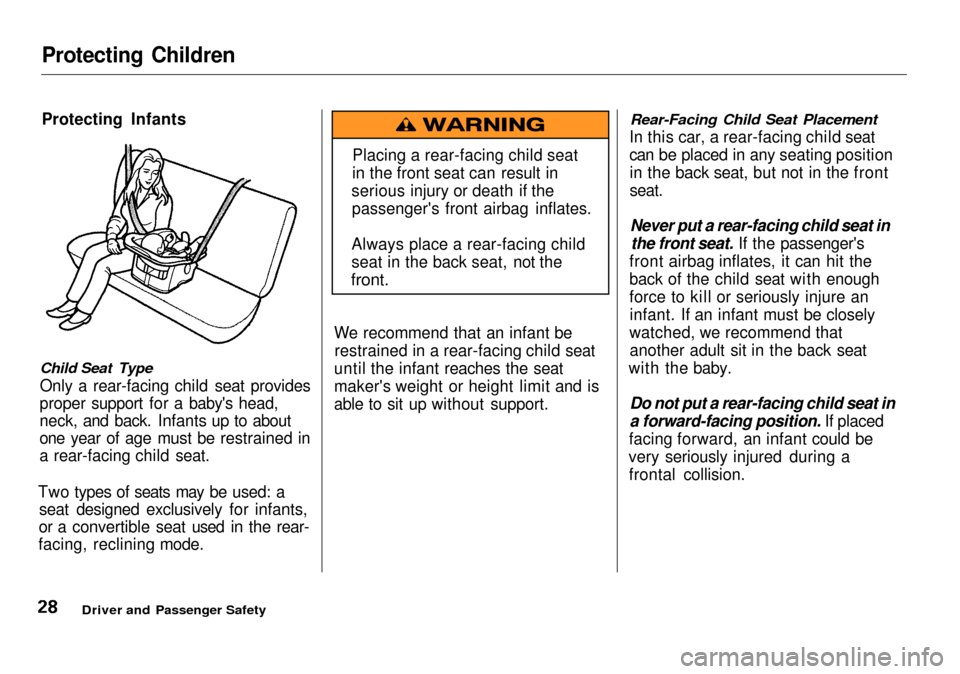
Protecting Children
Protecting Infants
Child Seat Type
Only a rear-facing child seat provides
proper support for a baby's head,
neck, and back. Infants up to about
one year of age must be restrained in
a rear-facing child seat.
Two types of seats may be used: a seat designed exclusively for infants,
or a convertible seat used in the rear-
facing, reclining mode. We recommend that an infant be
restrained in a rear-facing child seat
until the infant reaches the seat
maker's weight or height limit and is
able to sit up without support.
Rear-Facing Child Seat Placement
In this car, a rear-facing child seat
can be placed in any seating position in the back seat, but not in the front
seat.
Never put a rear-facing child seat in the front seat. If the passenger's
front airbag inflates, it can hit the
back of the child seat with enough
force to kill or seriously injure an infant. If an infant must be closely
watched, we recommend that another adult sit in the back seat
with the baby.
Do not put a rear-facing child seat in
a forward-facing position. If placed
facing forward, an infant could be
very seriously injured during a frontal collision.
Driver and Passenger Safety
Placing a rear-facing child seat
in the front seat can result in
serious injury or death if the passenger's front airbag inflates.
Always place a rear-facing child
seat in the back seat, not the
front.
Page 32 of 333
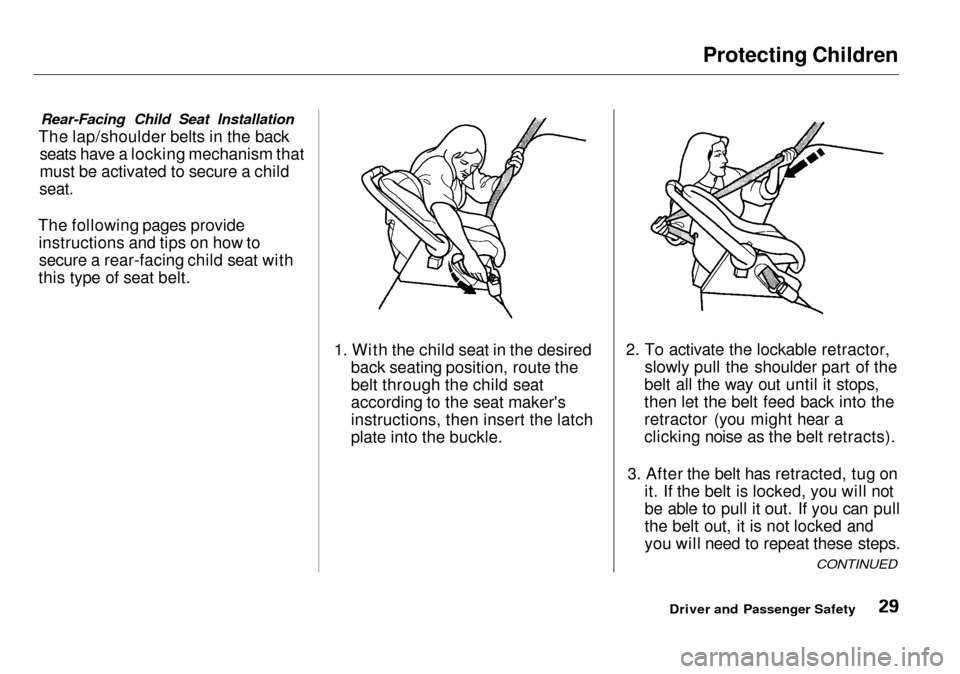
Protecting Children
Rear-Facing Child Seat Installation
The lap/shoulder belts in the back seats have a locking mechanism that
must be activated to secure a child
seat.
The following pages provide instructions and tips on how tosecure a rear-facing child seat with
this type of seat belt.
1. With the child seat in the desiredback seating position, route the
belt through the child seat
according to the seat maker's
instructions, then insert the latch
plate into the buckle. 2. To activate the lockable retractor,
slowly pull the shoulder part of the
belt all the way out until it stops,
then let the belt feed back into the
retractor (you might hear a
clicking noise as the belt retracts).
3. After the belt has retracted, tug on it. If the belt is locked, you will not
be able to pull it out. If you can pull
the belt out, it is not locked and
you will need to repeat these steps.
Driver and Passenger Safety
CONTINUED
Page 33 of 333
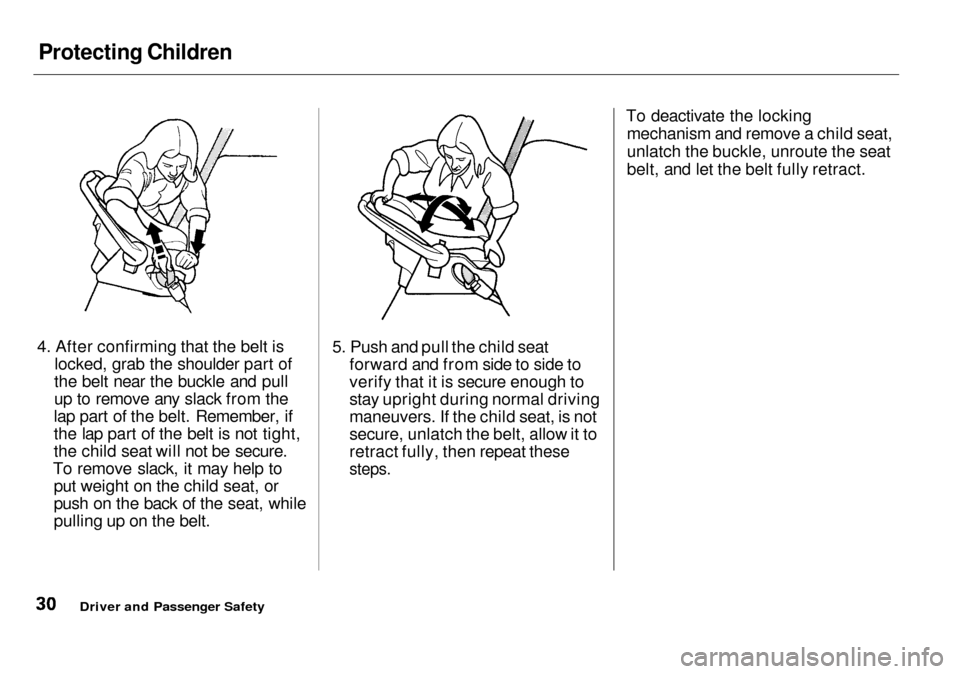
Protecting Children
4. After confirming that the belt is locked, grab the shoulder part of
the belt near the buckle and pull
up to remove any slack from the
lap part of the belt. Remember, if
the lap part of the belt is not tight,
the child seat will not be secure.
To remove slack, it may help to put weight on the child seat, or
push on the back of the seat, while
pulling up on the belt. 5. Push and pull the child seat
forward and from side to side to
verify that it is secure enough to
stay upright during normal driving
maneuvers. If the child seat, is not
secure, unlatch the belt, allow it to
retract fully, then repeat these
steps.
To deactivate the locking
mechanism and remove a child seat,
unlatch the buckle, unroute the seat
belt, and let the belt fully retract.
Driver and Passenger Safety
Page 34 of 333
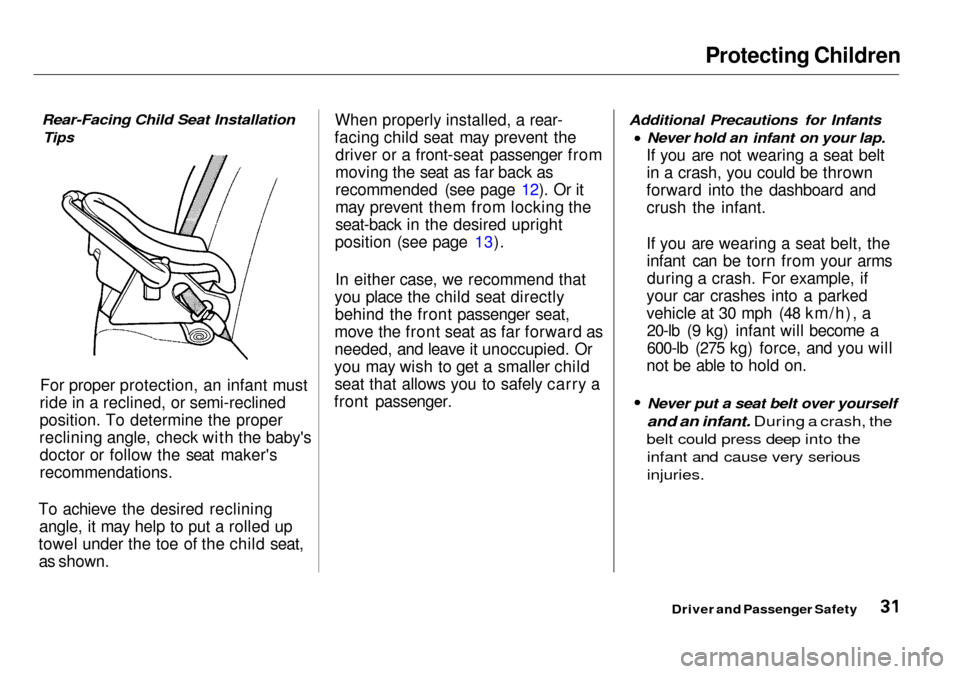
Protecting Children
Rear-Facing Child Seat Installation
Tips
For proper protection, an infant must
ride in a reclined, or semi-reclined
position. To determine the proper
reclining angle, check with the baby's doctor or follow the seat maker's
recommendations.
To achieve the desired reclining angle, it may help to put a rolled up
towel under the toe of the child seat, as shown. When properly installed, a rear-
facing child seat may prevent the driver or a front-seat passenger from
moving the seat as far back as
recommended (see page 12). Or it
may prevent them from locking the
seat-back in the desired upright
position (see page 13).
In either case, we recommend that
you place the child seat directly behind the front passenger seat,
move the front seat as far forward as
needed, and leave it unoccupied. Or
you may wish to get a smaller child seat that allows you to safely carry a
front passenger.
Additional Precautions for Infants
Never hold an infant on your lap.
If you are not wearing a seat belt in a crash, you could be thrown
forward into the dashboard and
crush the infant.
If you are wearing a seat belt, the infant can be torn from your arms
during a crash. For example, if
your car crashes into a parked
vehicle at 30 mph (48 km/h), a 20-lb (9 kg) infant will become a
600-lb (275 kg) force, and you will
not be able to hold on.
Never put a seat belt over yourself
and an infant. During a crash, the
belt could press deep into the infant and cause very serious
injuries.
Driver and Passenger Safety
Page 35 of 333
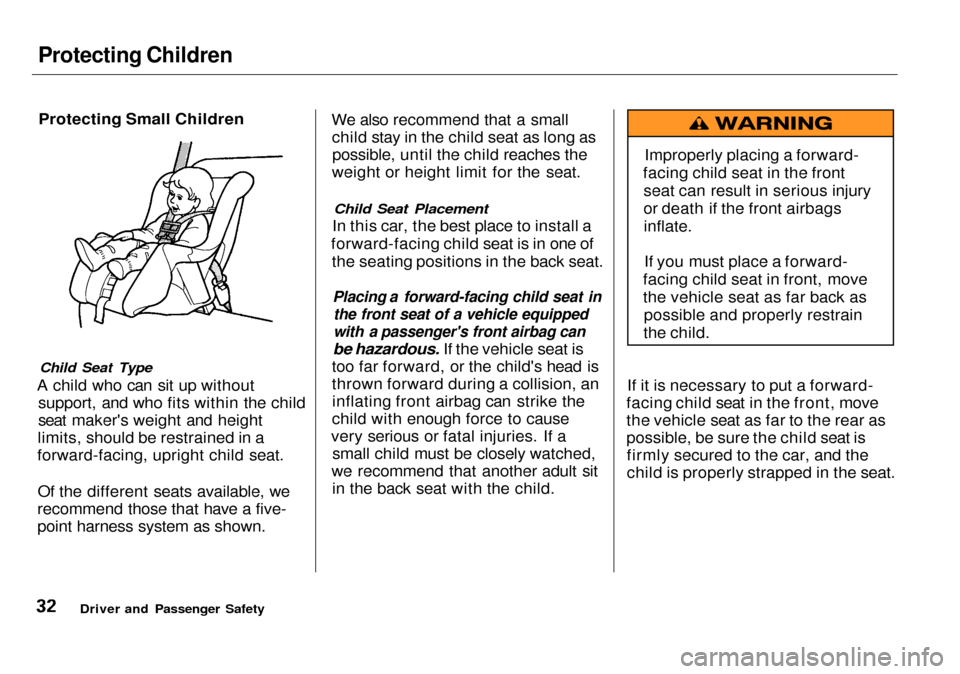
Protecting Children
Protecting Small Children
Child Seat Type
A child who can sit up without support, and who fits within the child
seat maker's weight and height
limits, should be restrained in a
forward-facing, upright child seat.
Of the different seats available, we
recommend those that have a five-
point harness system as shown. We also recommend that a small
child stay in the child seat as long aspossible, until the child reaches the
weight or height limit for the seat.
Child Seat Placement
In this car, the best place to install a
forward-facing child seat is in one of the seating positions in the back seat.
Placing a forward-facing child seat inthe front seat of a vehicle equipped
with a passenger's front airbag can
be hazardous. If the vehicle seat is
too far forward, or the child's head is
thrown forward during a collision, an inflating front airbag can strike the
child with enough force to cause
very serious or fatal injuries. If a small child must be closely watched,
we recommend that another adult sit in the back seat with the child. If it is necessary to put a forward-
facing child seat in the front, move
the vehicle seat as far to the rear as
possible, be sure the child seat is firmly secured to the car, and the
child is properly strapped in the seat.
Driver and Passenger Safety Improperly placing a forward-
facing child seat in the front seat can result in serious injury
or death if the front airbagsinflate.
If you must place a forward-
facing child seat in front, move
the vehicle seat as far back as possible and properly restrain
the child.
Page 36 of 333

Protecting Children
Child Seat Installation
The lap/shoulder belts in the back and front passenger seating positions
have a locking mechanism that must
be activated to secure a child seat.
The following pages provide instructions on how to secure a
forward-facing child seat with this type of seat belt.
1. With the child seat in the desiredseating position, route the belt
through the child seat according
to the seat maker's instructions, then insert the latch plate into the
buckle. 2. To activate the lockable retractor,
slowly pull the shoulder part of the
belt all the way out until it stops,
then let the belt feed back into the
retractor (you might hear a
clicking noise as the belt retracts).
3. After the belt has retracted, tug on it. If the belt is locked, you will not
be able to pull it out. If you can pull
the belt out, it is not locked and
you will need to repeat these steps.
Driver and Passenger Safety
CONTINUED
Page 37 of 333
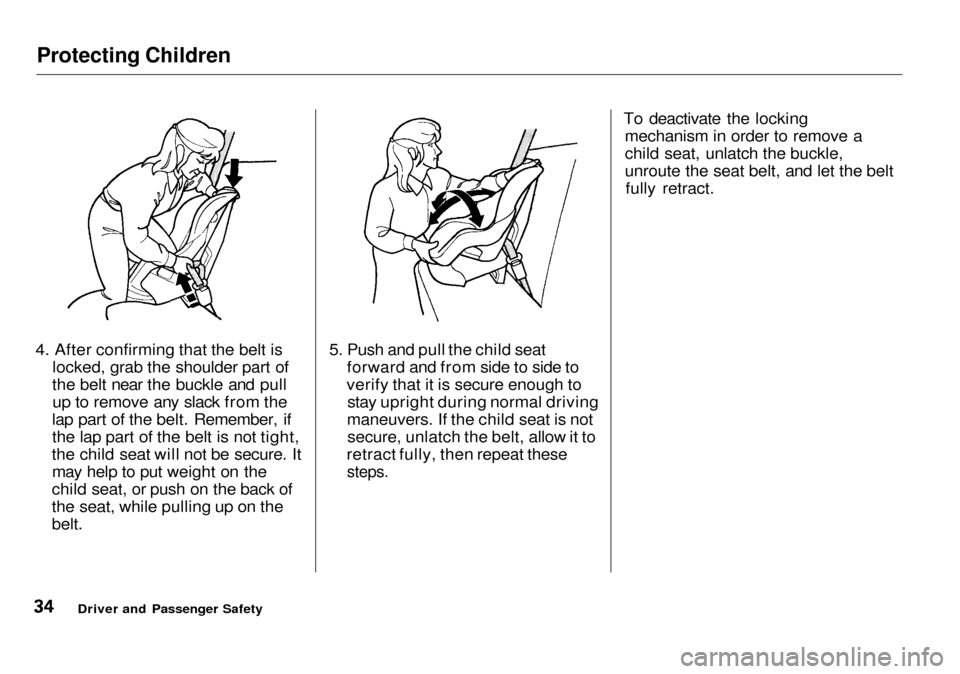
Protecting Children
4. After confirming that the belt is locked, grab the shoulder part of
the belt near the buckle and pull up to remove any slack from the
lap part of the belt. Remember, if
the lap part of the belt is not tight,
the child seat will not be secure. It may help to put weight on the
child seat, or push on the back of
the seat, while pulling up on the
belt. 5. Push and pull the child seat
forward and from side to side to
verify that it is secure enough to stay upright during normal driving
maneuvers. If the child seat is not secure, unlatch the belt, allow it to
retract fully, then repeat these
steps.
To deactivate the locking
mechanism in order to remove a
child seat, unlatch the buckle,
unroute the seat belt, and let the beltfully retract.
Driver and Passenger Safety
Page 38 of 333
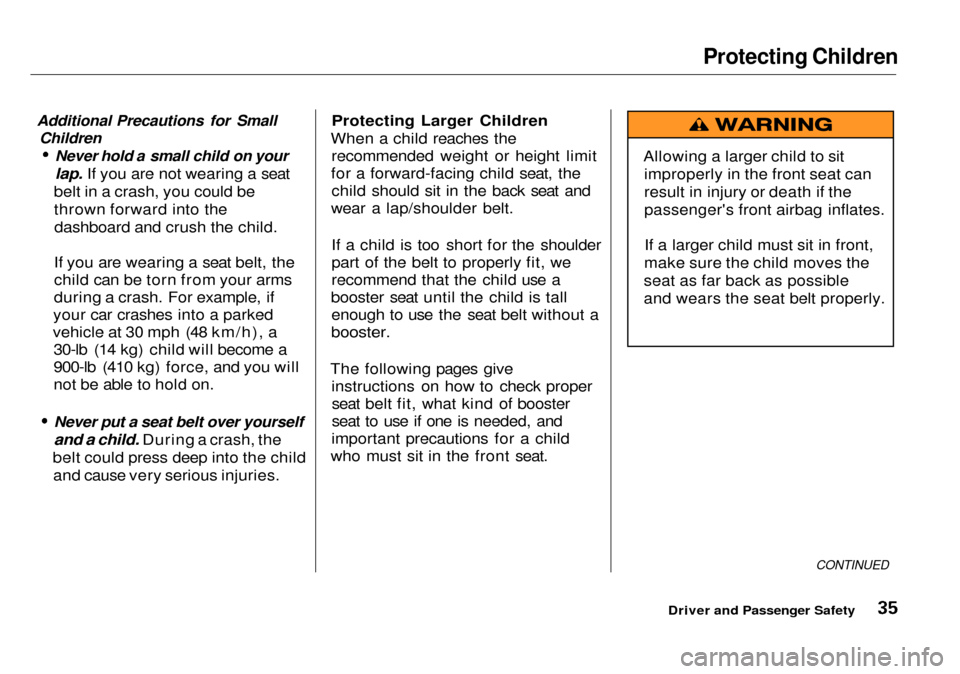
Protecting Children
Additional Precautions for Small
Children
Never hold a small child on your
lap. If you are not wearing a seat
belt in a crash, you could be
thrown forward into the dashboard and crush the child.
If you are wearing a seat belt, the
child can be torn from your arms
during a crash. For example, if
your car crashes into a parked
vehicle at 30 mph (48 km/h), a 30-lb (14 kg) child will become a
900-lb (410 kg) force, and you will
not be able to hold on.
Never put a seat belt over yourself
and a child. During a crash, the
belt could press deep into the child and cause very serious injuries. Protecting Larger Children
When a child reaches the recommended weight or height limit
for a forward-facing child seat, the child should sit in the back seat and
wear a lap/shoulder belt.
If a child is too short for the shoulder
part of the belt to properly fit, we
recommend that the child use a
booster seat until the child is tall enough to use the seat belt without a
booster.
The following pages give instructions on how to check properseat belt fit, what kind of booster
seat to use if one is needed, and
important precautions for a child
who must sit in the front seat.
CONTINUED
Driver and Passenger Safety
Allowing a larger child to sit
improperly in the front seat can
result in injury or death if the
passenger's front airbag inflates.
If a larger child must sit in front,
make sure the child moves the
seat as far back as possible
and wears the seat belt properly.
Page 39 of 333
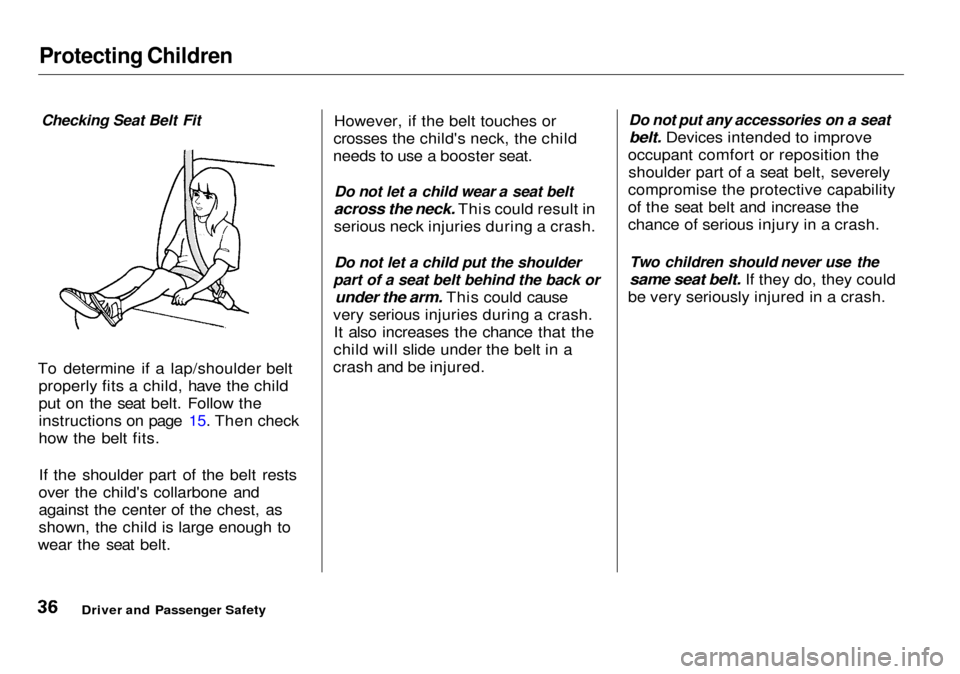
Protecting Children
Checking Seat Belt Fit
To determine if a lap/shoulder belt properly fits a child, have the child
put on the seat belt. Follow the
instructions on page 15. Then check
how the belt fits.
If the shoulder part of the belt rests
over the child's collarbone and
against the center of the chest, as
shown, the child is large enough to
wear the seat belt. However, if the belt touches or
crosses the child's neck, the child
needs to use a booster seat.
Do not let a child wear a seat belt
across the neck. This could result in
serious neck injuries during a crash.
Do not let a child put the shoulder
part of a seat belt behind the back or
under the arm. This could cause
very serious injuries during a crash. It also increases the chance that the
child will slide under the belt in a
crash and be injured.
Do not put any accessories on a seat
belt. Devices intended to improve
occupant comfort or reposition the shoulder part of a seat belt, severely
compromise the protective capability
of the seat belt and increase the
chance of serious injury in a crash.
Two children should never use the
same seat belt. If they do, they could
be very seriously injured in a crash.
Driver and Passenger Safety
Page 40 of 333
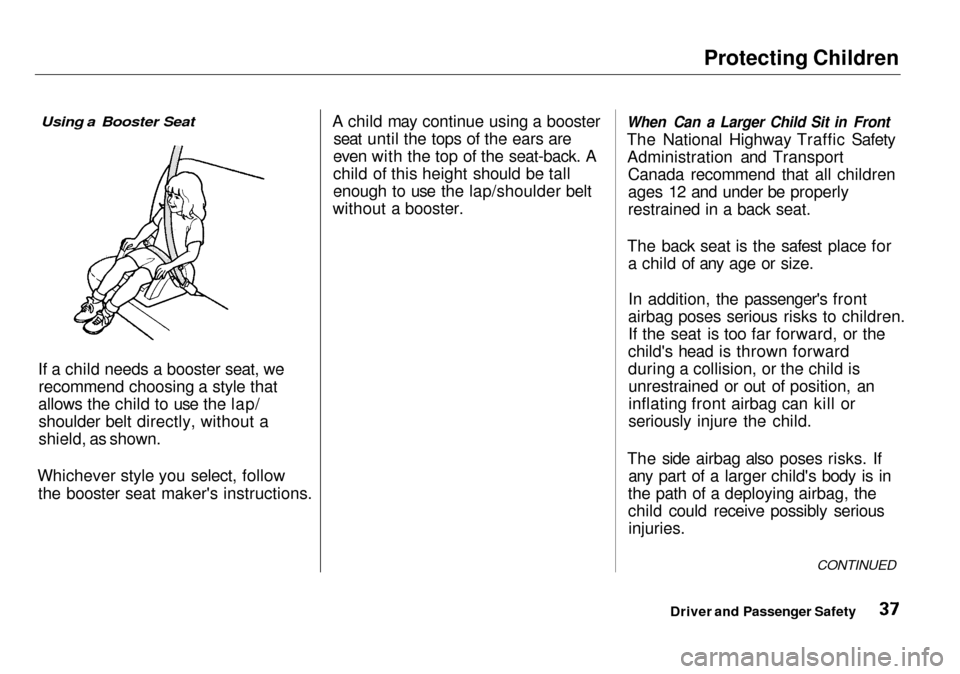
Protecting Children
Using a Booster Seat
If a child needs a booster seat, we recommend choosing a style that
allows the child to use the lap/ shoulder belt directly, without a
shield, as shown.
Whichever style you select, follow the booster seat maker's instructions. A child may continue using a booster
seat until the tops of the ears are
even with the top of the seat-back. A
child of this height should be tall
enough to use the lap/shoulder belt
without a booster.
When Can a Larger Child Sit in Front
The National Highway Traffic Safety Administration and Transport Canada recommend that all children
ages 12 and under be properly
restrained in a back seat.
The back seat is the safest place for a child of any age or size.
In addition, the passenger's front
airbag poses serious risks to children. If the seat is too far forward, or the
child's head is thrown forward
during a collision, or the child is unrestrained or out of position, an
inflating front airbag can kill or
seriously injure the child.
The side airbag also poses risks. If any part of a larger child's body is in
the path of a deploying airbag, the
child could receive possibly serious injuries.
Driver and Passenger Safety CONTINUED